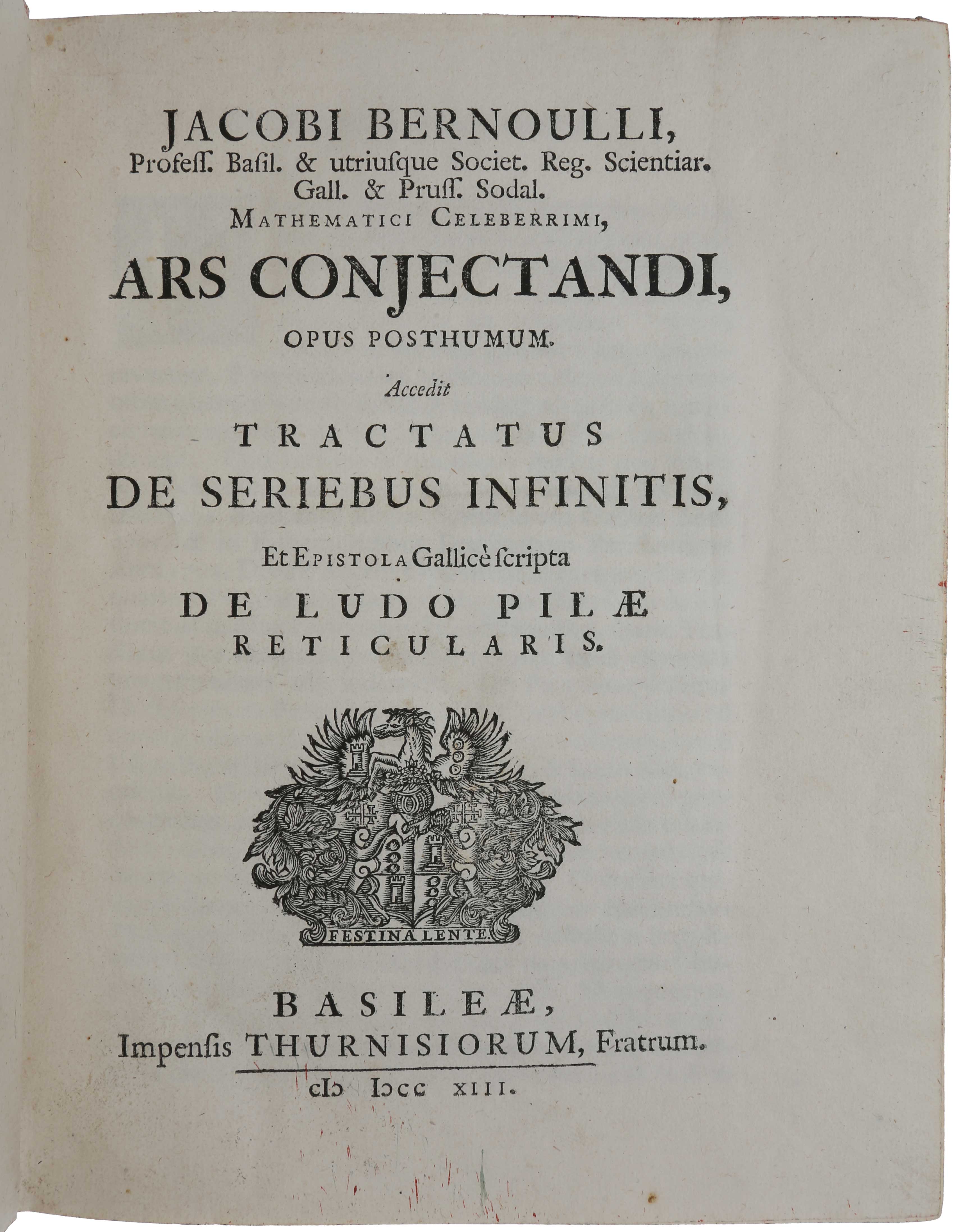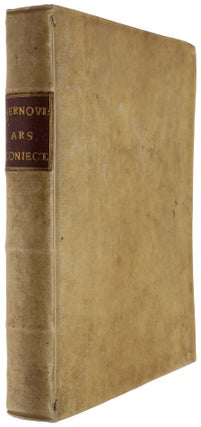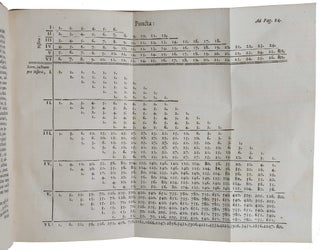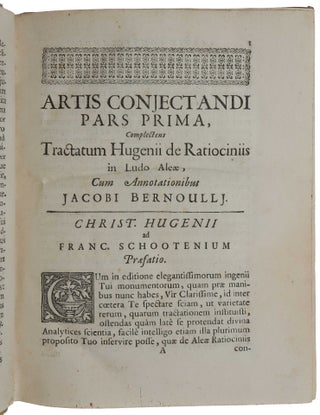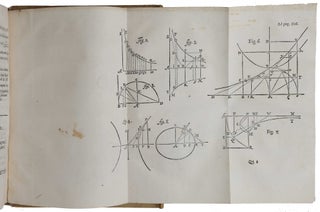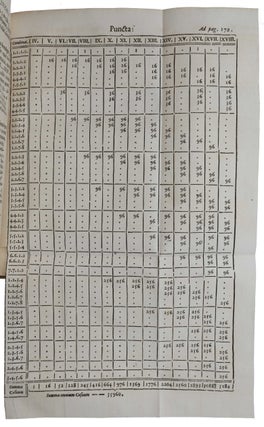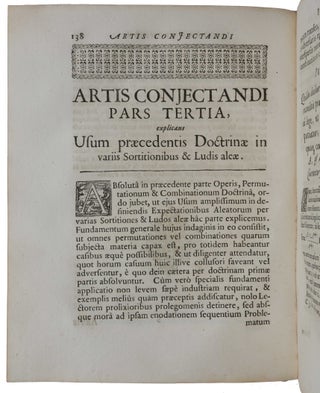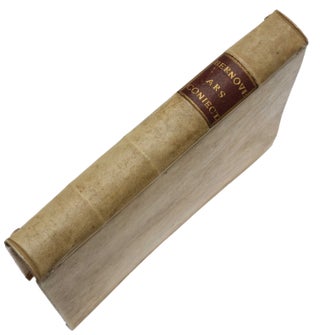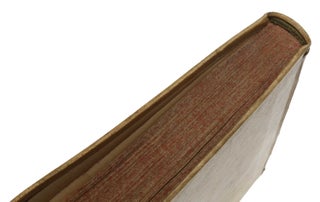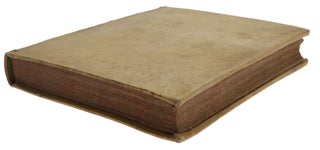Ars conjectandi, opus posthumum. Accedit Tractatus de seriebus infinitis, et Epistola Gallicè scripta De ludo pilae reticularis.
Basel: Impensis Thurnisiorum Fratum, 1713.
First edition, an exceptionally fine copy, rare in this condition. “Jakob 1 Bernoulli’s posthumous treatise, edited by his nephew [Nicholas I Bernoulli], (the title literally means “the art of
[dice] throwing”) was the first significant book on probability theory: it set forth the fundamental principles of the calculus of probabilities and contained the first suggestion that the theory could extend beyond the boundaries of mathematics to apply to civic, moral and economic affairs. The work is divided into four parts, the first a commentary on Huygens’s De ratiociniis in ludo aleae (1657), the second a treatise on permutations (a term Bernoulli invented) and combinations, containing the Bernoulli numbers,
and the third an application of the theory of combinations to various games of chance. The fourth and most important part contains Bernoulli’s philosophical thoughts on probability: probability as a measurable degree of certainty, necessity and chance, moral versus mathematical expectation, a priori and a posteriori probability, etc. It also contains his attempt to prove what is still called Bernoulli’s Theorem: that if the number of trials is made large enough, then the probability that the result will lie between certain limits will be as great as desired” (Norman). This was the first statement of the law of large numbers.
❦ PMM 179; Dibner 110; Evans 8; Grolier/Horblit 12; Sparrow 21; Norman 216.
“In the first Part (pp. 2-71) Jakob Bernoulli complemented his reprint of Huygens’s tract by extensive annotations which contained important modifications and generalisations. Bernoulli’s additions to Huygens’s tract are about four times as long as the original text. The central concept in Huygens’s tract is expectation. The expectation of a player A engaged in a game of chance in a certain situation is identified by Huygens with his share of the stakes if the game is not played or not continued in a ‘just’ game. For the determination of expectation Huygens had given three propositions which constitute the ‘theory’ of his calculus of games of chance. Huygens’s central proposition III maintains:
“If the number of cases I have for gaining a is p, and if the number of cases I have for gaining b is q, then assuming that all cases can happen equally easily, my expectation is worth (pa + qb)/(p + q).”
“Bernoulli not only gives a new proof for this proposition but also generalizes it in several ways …
“Huygens’s propositions IV to VII treat the problem of points, also called the problem of the division of stakes, for two players; propositions VIII and IX treat three and more players. Bernoulli returns to these problems in Part II of the Ars Conjectandi. In his annotations to Huygens’s proposition IV he generalised Huygens’s concept of expectation … This is the only instance in the annotations and commentaries to Huygens’s tract where Bernoulli uses the word ‘probabilitas’, or probability as understood in everyday life. Later in Part IV of the Ars Conjectandi Bernoulli replaced Huygens’s main concept, expectation, by the concept of probability for which he introduced the classical measure of favourable to all possible cases. The remaining propositions X to XIV of Huygens’s tract deal with dicing problems of the kind: What are the odds to throw a given number of points with two or three dice? or: With how many throws of a die can one undertake it to throw a six or a double six? … The meaning of Huygens’s result of proposition X, that the expectation of a player who contends to throw a six with four throws of a die is greater than that of his adversary, is explained by Bernoulli in a way which relates to the law of large numbers proved in Part IV of the Ars Conjectandi …
“In the second Part (pp. 72-137) Bernoulli deals with combinatorial analysis, based on contributions of van Schooten, Leibniz, Wallis, and Jean Prestet … [It] consists of nine chapters dealing with permutations, the number of combinations of all classes, the number of combinations of a particular class, figurate numbers and their properties (especially the multiplicative property), sums of powers of integers, the hypergeometric distribution, the problem of points for two players with equal chances to win a single game, combinations with repetitions and with restricted repetitions, and variations with repetitions and with restricted repetitions.
“Evidently Bernoulli did not know Blaise Pascal’s Triangle arithmétique, published posthumously in 1665, though Leibniz had alluded to it in his last letter to him in 1705. Not only does Bernoulli not mention Pascal in the list of authors that he had consulted concerning combinatorial analysis, except for Pascal’s letter to Fermat of 24 July 1654; it would also be difficult to explain why he repeated results already published by Pascal in the Triangle arithmétique, such as the multiplicative property for binomial coefficients for which Bernoulli claims the first proof for himself. His arrangement differs completely from that of Pascal, whose proof for the multiplicative property of the binomial coefficients has been judged to be clearer than Bernoulli’s. It is fair to add that in the Ars Conjectandi, which Bernoulli left as an unpublished manuscript, he was much more honest concerning the achievements of his predecessors than Pascal in the Triangle arithmétique. It is also true that Bernoulli was concerned with combinatorial analysis in the Ars Conjectandi first of all because it constituted for him a most useful and indispensable universal instrument for dealing numerically with conjectures, since ‘every conjecture is founded upon combinations of the effective causes’ (p. 73) …
“In the third Part (pp. 138-209) Bernoulli gives 24 problems concerning the determination of the modified Huygenian concept of expectation in various games. Here he uses extensively conditional expectations without, however, distinguishing them from unconditional expectations. All the games are games of chance with dice and cards including games en vogue at the French court of the time like Cinque et neuf, Trijaques, or Basette. He solves these problems mainly by combinatorial methods, as introduced in Part II, and by recursion …
“[The fourth Part] (pp. 210-239) is the most interesting and original Part; but it is the one that Bernoulli was not able to complete. In the first three of its five chapters it deals with the new central concept of the art of conjecturing, probability, its relation to certainty, necessity and chance, and ways of estimating and measuring probability” (Schneider, pp. 92-100). “The relevant point for our analysis is his introduction in the fourth part of Ars Conjectandi of what has come to be regarded as the first law of large numbers. Bernoulli began the discussion leading up to his theorem by noting that, in games employing homogeneous dice with similar faces or urns with equally accessible tickets of different colors, the a priori determination of chances was straightforward. One would simply enumerate the possible cases and take the ratio of the number of ‘fertile’ cases to the total number of cases, whether ‘fertile’ or ‘sterile.’ But, Bernoulli asked, what about problems such as those involving disease, weather, or games of skill, where the causes are hidden and the enumeration of equally likely cases impossible? In such situations, Bernoulli wrote, “It would be a sign of insanity to attempt to learn anything in this manner.” Instead, Bernoulli proposed to determine the probability of a fertile case a posteriori: “For it should be presumed that a particular thing will occur or not occur in the future as many times as it has been observed, in similar circumstances, to have occurred or not occurred in the past” (p. 224). The proportion of favorable or fertile cases could thus be determined empirically. Now this empirical approach to the determination of chances was not new with Bernoulli, nor did he consider it to be new. What was new was Bernoulli’s attempt to give formal treatment to the vague notion that the greater the accumulation of evidence about the unknown proportion of cases, the closer we are to certain knowledge about that proportion.
“Bernoulli took it as commonly known that uncertainty decreased as the number of observations increased: “For even the most stupid of men, by some instinct of nature, by himself and without any instruction (which is a remarkable thing), is convinced that the more observations have been made, the less danger there is of wandering from one's goal” (p. 225). Bernoulli sought both to provide a proof of this principle and to show that there was no natural lower bound to the residual uncertainty: By multiplying the observations, ‘moral certainty’ about the unknown proportion could be approached arbitrarily closely” (Stigler, pp. 64-5).
The main work concludes with Tractatus de seriebus infinitis earumque summa finite, et usu in quadraturis spatiorum & rectificationibus curvarum (pp. 241-306), which had first appeared as a series of five extremely rare pamphlets entitled Positiones arithmeticae de seriebus infinitis, earumque summa finita. “The five dissertations in the Theory of Series (1682–1704) contain sixty consecutively numbered propositions. These dissertations show how Bernoulli (at first in close cooperation with his brother) had thoroughly familiarized himself with the appropriate formulations of questions to which he had been led by the conclusions of Leibniz in 1682 (series for [pi]/4 and log 2) and 1683 (questions dealing with compound interest). Out of this there also came the treatise in which Bernoulli took into account short-term compound interest and was thus led to the exponential series. He thought that there had been nothing printed concerning the theory of series up until that time, but he was mistaken: most conclusions of the first two dissertations (1689, 1692) were already to be found in Pietro Mengoli (Novae quadraturae arithmeticae, seu de additione fractionum, 1650), as were the divergence of the harmonic series (Prop. 16) and the sum of the reciprocals of infinitely many figurate numbers (Props. 17–20) … At the end of the first dissertation Bernoulli acknowledged that he could not yet sum [the inverse squares of the integers] in closed form (Euler succeeded in doing so first in 1737) … Informative theses, based on Bernoulli’s earlier studies, were added to the dissertations: and theses 2 and 3 of the second dissertation are based on the still incomplete classification of curves of the third degree according to their shapes into thirty-three different types.
“The third dissertation was defended by Jakob Hermann, who wrote Bernoulli’s obituary notice in Acta eruditorum (1706). In the introduction L’Hospital’s Analyse is praised. After some introductory propositions, there appear the logarithmic series for the hyperbola quadrature (Prop. 42), the exponential series as the inverse of the logarithmic series (Prop. 43), … and the series for the arc of the circle and the sector of conic sections (Props. 45, 46). All of these are carefully and completely presented with reference to the pertinent results of Leibniz (1682; 1691). In 1698 previous work was supplemented by Bernoulli’s reflections on the catenary (Prop. 49) and related problems, on the rectification of the parabola (Prop. 41), and on the rectification of the logarithmic curve (Prop. 52).
“The last dissertation (1704) was defended by Bernoulli’s nephew, Nikolaus I, who helped in the publication of the Ars conjectandi (1713) and the reprint of the dissertation on series (1713) and became a prominent authority in the theory of series. In the dissertation Bernoulli first (Prop. 53) praises Wallis’ interpolation through incomplete induction. In Proposition 54 the binomial theorem is presented, with examples of fractional exponents, as an already generally known theorem. Probably for this reason there is no reference to Newton’s presentation in his letters to Leibniz of 23 June and 3 November 1676, which were made accessible to Bernoulli when they were published in Wallis’ Opera (Vol. III, 1699)” (DSB).
The volume concludes with a separately-paginated 35-page Lettre à un Amy, sur les Parties du Jeu de Paume (in French). “In his Letter to a Friend on the Game of Tennis, Bernoulli begins with a summary of his considerations in the Ars Conjectandi on the difference between games of chance and games that depend on the skill of the players, on the corresponding determination of probabilities a priori and a posteriori, and on the law of large numbers, which justifies the use of the relative frequency of winning as a measure of the probability of winning. Apart from this short introduction, the letter is really an exercise in probability theory and could well have been included in Part 3 of the Ars Conjectand. “Bernoulli writes that he will not explain the rules of the game because they are well known. The game is more complicated than tennis but with the same scoring rules … Bernoulli analyzes many problems of tennis. There are, however, no new methods used in his analysis; he keeps strictly to the methods used by Huygens, solving most of the problems by recursion between expectations. The letter is an imposing work, demonstrating Bernoulli's pedagogical qualities, his ability to systematize, and his thoroughness” (Hald, p. 241).
“Important sections of the Ars Conjectandi were sketched out in Jakob Bernoulli’s scientific diary, the ‘Meditationes’, from the mid 1680s onwards. When he died in 1705, the Ars Conjectandi was not finished, especially lacking good examples for the applications of his ‘art of conjecturing’ to what he described as civil and moral affairs. Concerning the time that it would have needed to complete it, opinions differ from a few weeks to quite a few years, depending on assumptions about his own understanding of completeness. His heirs did not want his brother Johann, the leading mathematician in Europe at this time, to complete and edit the manuscript, fearing that Johann would exploit his brother’s work. Only after Pierre Rémond de Montmort (1678-1719), himself a pioneer of the theory of probability, had sent an offer via Johann to print the manuscript at his own expense in 1710, and after some admonitions that the Ars conjectandi soon would become obsolete if not published, Jakob’s son, a painter, agreed to have the unaltered manuscript printed. It appeared in August 1713 … A short preface was contributed by Nikolaus Bernoulli (1687-1759), Jakob’s nephew. He had read the manuscript when his uncle was still alive, and had made considerable use of it in his thesis of 1709 [De usu artis conjectandi in jure] and in his correspondence with Montmort. He was asked twice to complete and edit the manuscript. The first time he excused himself by his absence when he travelled in 1712 to Holland, England and France. After his return Nikolaus Bernoulli declared himself as too inexperienced to do the job and in his preface he asked Montmort, the anonymous author of the Essay sur les jeux de hazard, and Abraham de Moivre (1667-1754) to complete his uncle’s work” (Schneider, p. 90).
Hald, History of Probability and Statistics and their Applications before 1750, 2003. Schneider, ‘Jakob Bernoulli, Ars Conjectandi (1713)’, pp. 88-104 in Landmark Writings in Western Mathematics 1640-1940, I. Grattan-Guinness (ed.), 2005. Stigler, The History of Statistics, 1986.
4to (202 x 155 mm), contemporary vellum, red spine label with gilt lettering, [4] 1-306, 1-35 [1], printed folding tables between pp. 24-25 and 172-173, folding woodcut diagram after p. 306. An outstanding copy, in entirely unrestored binding, very fresh and crisp internally. Very rare in such fine condition.
Item #4063
Price: $40,000.00

